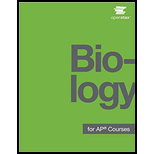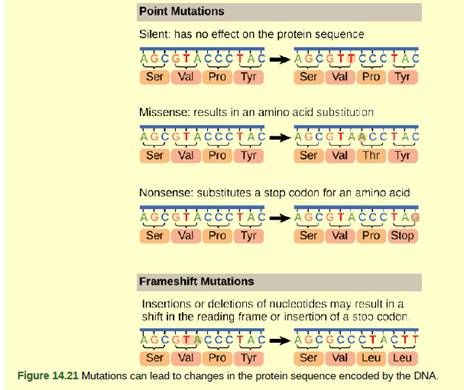
BIOLOGY FOR AP COURSES (OER)
17th Edition
ISBN: 9781947172401
Author: OpenStax
Publisher: OpenStax
expand_more
expand_more
format_list_bulleted
Concept explainers
Textbook Question
Chapter 14, Problem 3VCQ
Figure 14.21 A fr am eshift mutation that results in the insertion of three nucleotides is often less deleterious than a mutation that results in the insertion of one

Expert Solution & Answer
Want to see the full answer?
Check out a sample textbook solution
Students have asked these similar questions
C
MasteringHealth MasteringNu ×
session.healthandnutrition-mastering.pearson.com/myct/itemView?assignment ProblemID=17396416&attemptNo=1&offset=prev
10. Your instructor will give you 2 amino acids during the activity session (video 2-7.
A. First color all the polar and non-polar covalent bonds in the R groups of your 2 amino acids
using the same colors as in #7. Do not color the bonds in the backbone of each amino acid.
B. Next, color where all the hydrogen bonds, hydrophobic interactions and ionic bonds could
occur in the R group of each amino acid. Use the same colors as in #7. Do not color the bonds
in the backbone of each amino acid.
C. Position the two amino acids on the page below in an orientation where the two R groups
could bond together. Once you are satisfied, staple or tape the amino acids in place and label
the bond that you formed between the two R groups.
- Polar covalent Bond - Red
- Non polar Covalent boND- yellow
- Ionic BonD - PINK
Hydrogen Bonn - Purple
Hydrophobic interaction-green
O=C-N
H
I.
H
HO
H
=O
CH2
C-C-N
HICK
H
HO
H
CH2
OH
H₂N
C = O
Find the dental formula and enter it in the following format:
I3/3 C1/1 P4/4 M2/3 = 42 (this is not the correct number, just the correct format)
Please be aware: the upper jaw is intact (all teeth are present). The bottom jaw/mandible is not intact. The front teeth should include 6 total rectangular teeth (3 on each side) and 2 total large triangular teeth (1 on each side).
Chapter 14 Solutions
BIOLOGY FOR AP COURSES (OER)
Ch. 14 - Figure 14.10 In eukaryotic cells, DNA and RNA...Ch. 14 - Figure 14.14 You isolate a cell strain in which...Ch. 14 - Figure 14.21 A fr am eshift mutation that results...Ch. 14 - If DNA of a particular species was analyzed and it...Ch. 14 - The experiments by Hershey and Chase helped...Ch. 14 - Bacterial transformation is a major concern in...Ch. 14 - DNA double helix does not have which of the...Ch. 14 - In eukaryotes, what is the DNA wrapped around?...Ch. 14 - Meselson and Stahl's experiments proved that DNA...Ch. 14 - If the sequence of the 5'-3' strand is AATGCTAC,...
Ch. 14 - How did Meselson and Stahl support Watson and...Ch. 14 - Which of the following components is not involved...Ch. 14 - Which of the following does the enzyme primase...Ch. 14 - In which direction does DNA replication take...Ch. 14 - A scientist randomly mutates the DNA of a...Ch. 14 - The ends of the linear chromosomes are maintained...Ch. 14 - Which of the following is not a true statement...Ch. 14 - During proofreading, which of the following...Ch. 14 - The initial mechanism for repairing nucleotide...Ch. 14 - A scientist creates fruit fly larvae with a...Ch. 14 - Explain Griffith's transformation experiments What...Ch. 14 - Why were radioactive sulfur and phosphorous used...Ch. 14 - When Chargaffwas performing his experiments, the...Ch. 14 - Provide a brief summary of the Sanger sequencing...Ch. 14 - Describe the structure and complementary base...Ch. 14 - Prokaryotes have a single circular chromosome...Ch. 14 - How did the scientific community learn that DNA...Ch. 14 - Imagine the Meselson and Stahl experiments had...Ch. 14 - DNA replication is bidirectional and...Ch. 14 - What are Okazaki fragments and how they are...Ch. 14 - If the rate of replication in a particular...Ch. 14 - Explain the events taking place at the replication...Ch. 14 - What is the role of a primer in DNA replication?...Ch. 14 - Quinolone antibiotics treat bacterial infections...Ch. 14 - How do the linear chromosomes in eukaryotes ensure...Ch. 14 - What is the consequence of mutation of a mismatch...Ch. 14 - An adult with a history of tanning has his genome...
Additional Science Textbook Solutions
Find more solutions based on key concepts
3. CAUTION Why is genetic drift aptly named?
a. It causes allele frequencies to drift up or down randomly.
b. I...
Biological Science (6th Edition)
13. A 50 kg box hangs from rope. What is the tension in the rope if:
a. The box is at rest?
b. The box moves ...
Physics for Scientists and Engineers: A Strategic Approach, Vol. 1 (Chs 1-21) (4th Edition)
17. Anthropologists are interested in locating areas in Africa where fossils 4-8 million years old might be fou...
Campbell Biology: Concepts & Connections (9th Edition)
Some organizations are starting to envision a sustainable societyone in which each generation inherits sufficie...
Campbell Essential Biology (7th Edition)
Why is living epithelial tissue limited to a certain thickness?
Human Anatomy & Physiology (2nd Edition)
Endospore formation is called (a) _____. It is initiated by (b) _____. Formation of a new cell from an endospor...
Microbiology: An Introduction
Knowledge Booster
Learn more about
Need a deep-dive on the concept behind this application? Look no further. Learn more about this topic, biology and related others by exploring similar questions and additional content below.Similar questions
- 12. Calculate the area of a circle which has a radius of 1200 μm. Give your answer in mm² in scientific notation with the correct number of significant figures.arrow_forwardDescribe the image quality of the B.megaterium at 1000X before adding oil? What does adding oil do to the quality of the image?arrow_forwardWhich of the follwowing cells from this lab do you expect to have a nucleus and why or why not? Ceratium, Bacillus megaterium and Cheek epithelial cells?arrow_forward
- 14. If you determine there to be debris on your ocular lens, explain what is the best way to clean it off without damaging the lens?arrow_forward11. Write a simple formula for converting mm to μm when the number of mm's is known. Use the variable X to represent the number of mm's in your formula.arrow_forward13. When a smear containing cells is dried, the cells shrink due to the loss of water. What technique could you use to visualize and measure living cells without heat-fixing them? Hint: you did this technique in part I.arrow_forward
- 10. Write a simple formula for converting μm to mm when the number of μm's are known. Use the variable X to represent the number of um's in your formula.arrow_forward8. How many μm² is in one cm²; express the result in scientific notation. Show your calculations. 1 cm = 10 mm; 1 mm = 1000 μmarrow_forwardFind the dental formula and enter it in the following format: I3/3 C1/1 P4/4 M2/3 = 42 (this is not the correct number, just the correct format) Please be aware: the upper jaw is intact (all teeth are present). The bottom jaw/mandible is not intact. The front teeth should include 6 total rectangular teeth (3 on each side) and 2 total large triangular teeth (1 on each side).arrow_forward
- Answer iarrow_forwardAnswerarrow_forwardcalculate the questions showing the solution including variables,unit and equations all the questiosn below using the data a) B1, b) B2, c) hybrid rate constant (1) d) hybrid rate constant (2) e) t1/2,dist f) t1/2,elim g) k10 h) k12 i) k21 j) initial concentration (C0) k) central compartment volume (V1) l) steady-state volume (Vss) m) clearance (CL) AUC (0→10 min) using trapezoidal rule n) AUC (20→30 min) using trapezoidal rule o) AUCtail (AUC360→∞) p) total AUC (using short cut method) q) volume from AUC (VAUC)arrow_forward
arrow_back_ios
SEE MORE QUESTIONS
arrow_forward_ios
Recommended textbooks for you
 Human Heredity: Principles and Issues (MindTap Co...BiologyISBN:9781305251052Author:Michael CummingsPublisher:Cengage Learning
Human Heredity: Principles and Issues (MindTap Co...BiologyISBN:9781305251052Author:Michael CummingsPublisher:Cengage Learning Biology Today and Tomorrow without Physiology (Mi...BiologyISBN:9781305117396Author:Cecie Starr, Christine Evers, Lisa StarrPublisher:Cengage Learning
Biology Today and Tomorrow without Physiology (Mi...BiologyISBN:9781305117396Author:Cecie Starr, Christine Evers, Lisa StarrPublisher:Cengage Learning Biology 2eBiologyISBN:9781947172517Author:Matthew Douglas, Jung Choi, Mary Ann ClarkPublisher:OpenStax
Biology 2eBiologyISBN:9781947172517Author:Matthew Douglas, Jung Choi, Mary Ann ClarkPublisher:OpenStax Biology (MindTap Course List)BiologyISBN:9781337392938Author:Eldra Solomon, Charles Martin, Diana W. Martin, Linda R. BergPublisher:Cengage Learning
Biology (MindTap Course List)BiologyISBN:9781337392938Author:Eldra Solomon, Charles Martin, Diana W. Martin, Linda R. BergPublisher:Cengage Learning BiochemistryBiochemistryISBN:9781305577206Author:Reginald H. Garrett, Charles M. GrishamPublisher:Cengage Learning
BiochemistryBiochemistryISBN:9781305577206Author:Reginald H. Garrett, Charles M. GrishamPublisher:Cengage Learning

Human Heredity: Principles and Issues (MindTap Co...
Biology
ISBN:9781305251052
Author:Michael Cummings
Publisher:Cengage Learning

Biology Today and Tomorrow without Physiology (Mi...
Biology
ISBN:9781305117396
Author:Cecie Starr, Christine Evers, Lisa Starr
Publisher:Cengage Learning

Biology 2e
Biology
ISBN:9781947172517
Author:Matthew Douglas, Jung Choi, Mary Ann Clark
Publisher:OpenStax

Biology (MindTap Course List)
Biology
ISBN:9781337392938
Author:Eldra Solomon, Charles Martin, Diana W. Martin, Linda R. Berg
Publisher:Cengage Learning

Biochemistry
Biochemistry
ISBN:9781305577206
Author:Reginald H. Garrett, Charles M. Grisham
Publisher:Cengage Learning

Mitochondrial mutations; Author: Useful Genetics;https://www.youtube.com/watch?v=GvgXe-3RJeU;License: CC-BY